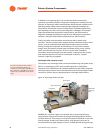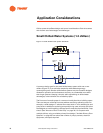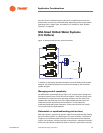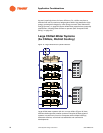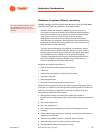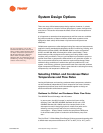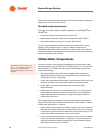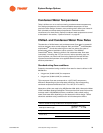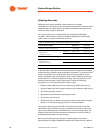
24 Chiller System Design and Control SYS-APM001-EN
Application Considerations
To minimize power, large systems must be very efficient. The upside of a
large system is the amplification of energy savings. A relatively small
percentage of energy saved becomes more valuable. For this reason, the
highly efficient series-counterflow arrangement is popular for large systems.
(See “Series–Counterflow Application” on page 77.)
Controls
The designers of medium and large chilled-water systems are more likely to
consider the pros and cons of direct-digital controls (DDC) versus
programmable-logic controls (PLC). These platforms deliver similar results,
depending on proper design, programming, commissioning, and operation.
One way to think of PLC is “fast, centralized control with redundancy.” PLC
has a faster processing speed, with some hot-redundancy features—such as
an entirely redundant system processor that is ready to take over if the main
system processor fails.
Conversely, DDC can be considered “steady, distributed control with
reliability.” DDC controls feature easy programming and user-friendly
operation. In the DDC environment, a failure of the system processor results
in the lower-level processors defaulting to a pre-determined operating mode.
The speed of the PLC system can be one of its challenges. Controls that are
steady and do not overreact to minor changes work very well, even in large
chilled-water systems.
Chiller Plant System Performance
Chiller performance testing
All major chiller manufacturers have chiller performance test facilities in the
factory, in a laboratory, or both. A chiller performance test in accordance with
the test procedures in ARI Standard 550/590
5
can be performed at the factory
under controlled conditions, with industrial grade instrumentation and
computerized data collection devices. This test ensures that the chiller meets
its promised performance criteria. If it does not, corrections are made before
it leaves the factory.
Limitations of field performance testing
After the chiller is installed at the job site, the system conditions will be less
controllable than in a test facility, and therefore unsuitable for chiller
acceptance testing. While measuring the performance of the entire chiller
plant is more difficult, it can help identify operating problems or evaluate the
effectiveness of system control methods and setpoints.
The goal is to operate as efficiently as possible and to sustain a high level of
individual equipment and coordinated operation. A proper energy
management system can help trend and diagnose problems or changes over
time.
For more information about chiller plant
controls, consult the Trane applications
guide, Tracer Summit™ Chiller Plant
Control Program (BAS-APG004-EN).



